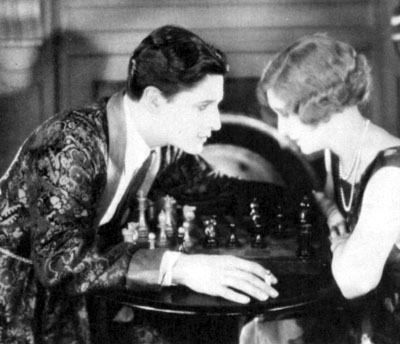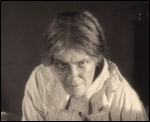THE LODGER 1926, PG, 75 mins

The Lodger was Hitchcock's third feature film but it was the one that established his reputation as a director of taut and suspenseful thrillers.
London is terrorised by a serial killer known as The Avenger (loosely based on Jack the Ripper), who is murdering young blonde women. The Buntings have rented a room to a mysterious lodger, Jonathan Drew (Novello), who eventually falls in love with their daughter, Daisy (June-yes, like Madonna, she has no professional surname). Daisy is engaged to Joe (Keen), who happens to be assigned to The Avenger case. After uncovering some apparent clues, such as Jonathan's leaving the house in the middle of the night, the Buntings suspect that the lodger could be the killer, and Joe, who is jealous of Jonathan, is only too keen to have him arrested.
The film foreshadows many of Hitchcock's techniques and themes used in his later films. There is a sparsity of intertitles compared with many silent movies, as Hitchcock tries to convey story and atmosphere through visual means. If you're trying to spot Hitchcock, he appears at a desk in the newsroom early in the film.
Review, Tony Fidanza, 12-14-2001
The Lodger, AKA: The Case of Jonathan Drew
1926 75 mins Drama B&W - Silent
Plot Synopsis
The first true Hitchcock film was The Lodger, ostensibly about Jack the Ripper, but this is left open. The concept of suspicion, though, was the crux of the picture and the basis for suspense. Adapted from the novel of the same name, the plot was basically: was the new boarder in the lodging house Jack the Ripper? The suspense mounts until even the audience - who up to that time considered the boarder innocent thinks he is the killer. This is the first appearance of the theme of many later Hitchcock films: that of the wrong man accused of a crime and his escape from the people in pursuit. The distribution company, Wardour, on first viewing thought The Lodger was terrible and cancelled its bookings. Even with the drawing power of its matinee-idol star Ivor Novello, The Lodger just could not interest the distributor. A few months later a new screening was arranged.
After Wardour asked Hitchcock to make some small changes, it released The Lodger to reviews calling it about the best British picture ever made. No doubt this was due to the many technical tricks Hitchcock created for the film. For example, when the landlady hears the lodger's footsteps above, she "sees" them in what looks like a double-exposure but is actually a plate glass floor. The use of lighting to create the suggest shadows which haunt the film, and the gripping mob scene at the end of the film-with the lodger in handcuffs hanging on an iron fence, alluding to the crucifixion are also significant. All of these trend-setting innovations were controversial in their day, but they worked then as they now. Luckily the boarder has been discovered to be innocent and is saved from the mob which rounds him. He too is after the killer, as his sister was a victim.
Extract© Richard A. Harris, Michael S. Lasky: The Complete Films of Alfred Hitchcock
Lodger, The: A Story of the London Fog (1926)
Courtesy of Carlton International
- Director Alfred Hitchcock
- Production Company Gainsborough Pictures
- Presented by Michael Balcon
- Photography Gaetano Ventimiglia
- Scenario Eliot Stannard
- From the novel by Marie Belloc-Lowndes
London is being terrorised by a Jack the Ripper-style murderer, the Avenger, who targets young blond-haired women. A mysterious new lodger arrives at the home of Mr and Mrs Bunting, whose daughter Daisy is courted by a policeman on the case. When the lodger begins behaving strangely, he attracts suspicion, particularly when he shows an interest in Daisy.
Made in 1926 for Michael Balcon's new Gainsborough studios, The Lodger: A Story of the London Fog was Hitchcock's first thriller, and his first critical and commercial success. Coming shortly after his return from Germany, it draws heavily on the German expressionist tradition established in such films as The Cabinet of Dr Caligari (Der Cabinett des Dr Caligari, d. Robert Weine, 1919) and Nosferatu (Nosferatu: eine Symphonie des Grauens, d. F.W. Murnau, 1922). These films, which used stylised, angular sets, high contrast light and shadow to convey disturbed psychological states, were to be a major influence on the developing director.
The Lodger was written by Eliot Stannard from a popular novel by Marie Belloc Lowndes (sister of the poet Hilaire Belloc), and starred matinee idol Ivor Novello - who starred in Hitchcock's next film, Downhill (1927) - as the mysterious lodger who falls under suspicion. Novello reprised this role in a sound remake directed by Maurice Elvey (1932). June Tripp, the young actress who starred as the landlady's daughter, Daisy, was the second of a series of actresses who became blonde at Hitchcock's insistence - the first was Virginia Valli, star of The Pleasure Garden (1925). Joe, Daisy's policeman fiancé, jokes, "I'm keen on golden hair myself, same as the Avenger is". It soon became clear that Hitchcock had similar tastes.
The Lodger was a great success, and quickly established Hitchcock as a name director. But the film was almost not released at all. After a private industry screening, distributor C.M. Woolf, told the director, "Your picture is so dreadful, that we're just going to put it on the shelf and forget about it". In the end the film was released, thanks to the championing of Michael Balcon, and to a young film enthusiast, Ivor Montagu. While Hitchcock re-shot a few rough sequences, Montagu reduced the number of title cards by three-quarters, and added designs by artist E.McKnight Kauffer. This was the version which was shown to the press in September 1926, to be described in glowing terms by trade journal Bioscope: "It is possible that this film is the finest British production ever made".
The film is also notable for the first of Hitchcock's characteristic cameo appearances, as a newspaper editor - he claimed his part was due to the non-appearance of a bit-part actor. Hitchcock's wife and collaborator Alma Reville also makes a brief appearance.
Review: Mark Duguid
Cast
- The lodger ... NOVELLO, Ivor
- Joe Betts, police detective ... KEEN, Malcolm
- Daisy Bunting ... JUNE, Miss
- Mr Bunting, the landlady's husband ... CHESNEY, Arthur
- Mrs Bunting, the landlady ... AULT, Marie
- [man in newsroom/on-looker at arrest?] ... HITCHCOCK, Alfred
- [woman listening to wireless] ... REVILLE, Alma
Credits
- Production Company Gainsborough Pictures
- From the novel by BELLOC-LOWNDES, Marie
- Presented by BALCON, Michael
- Assistant Director REVILLE, Alma
- [Screenplay] HITCHCOCK, Alfred
- Scenario STANNARD, Eliot
- [Director of Photography] YOUNG, Hal
- Photography VENTIMIGLIA, Gaetano
- Editing MONTAGU, Ivor
- Art Director ARNOLD, Wilfred
- Art Director EVANS, Bertram
- Title Design KAUFFER, E. McKnight
- Titling MONTAGU, Ivor
- Director HITCHCOCK, Alfred
- Presented by BLACKWELL, Carlyle

Alfred Hitchcock found his calling with The Lodger, his first characteristic thriller. It tells the story of a mysterious man who rents an upstairs room from a family in a time when Jack the Ripper is terrorizing London with a series of brutal murders. Hitchcock would perfect his style over the next several films, but the seed of genius is clearly visible here.
Eerie thriller based on the story of Jack the Ripper. Hitchcock's third film and a clear indication that masterpieces would follow
Foggy London town is gripped by fear as a vicious serial killer known only as The Avenger stalks the streets. A family becomes suspicious when their new lodger shows signs of nervous agitation and starts taking midnight strolls.
Despite being only Hitch's third (completed) film, many of the hallmarks of his direction are already recognizable, including a case of mistaken identity, discomforting sexual undertones and the exaggerated significance of simple actions to maximize the tension.
Novello, who plays the lodger, would repeat his role in Maurice Elvey's 1932 remake.